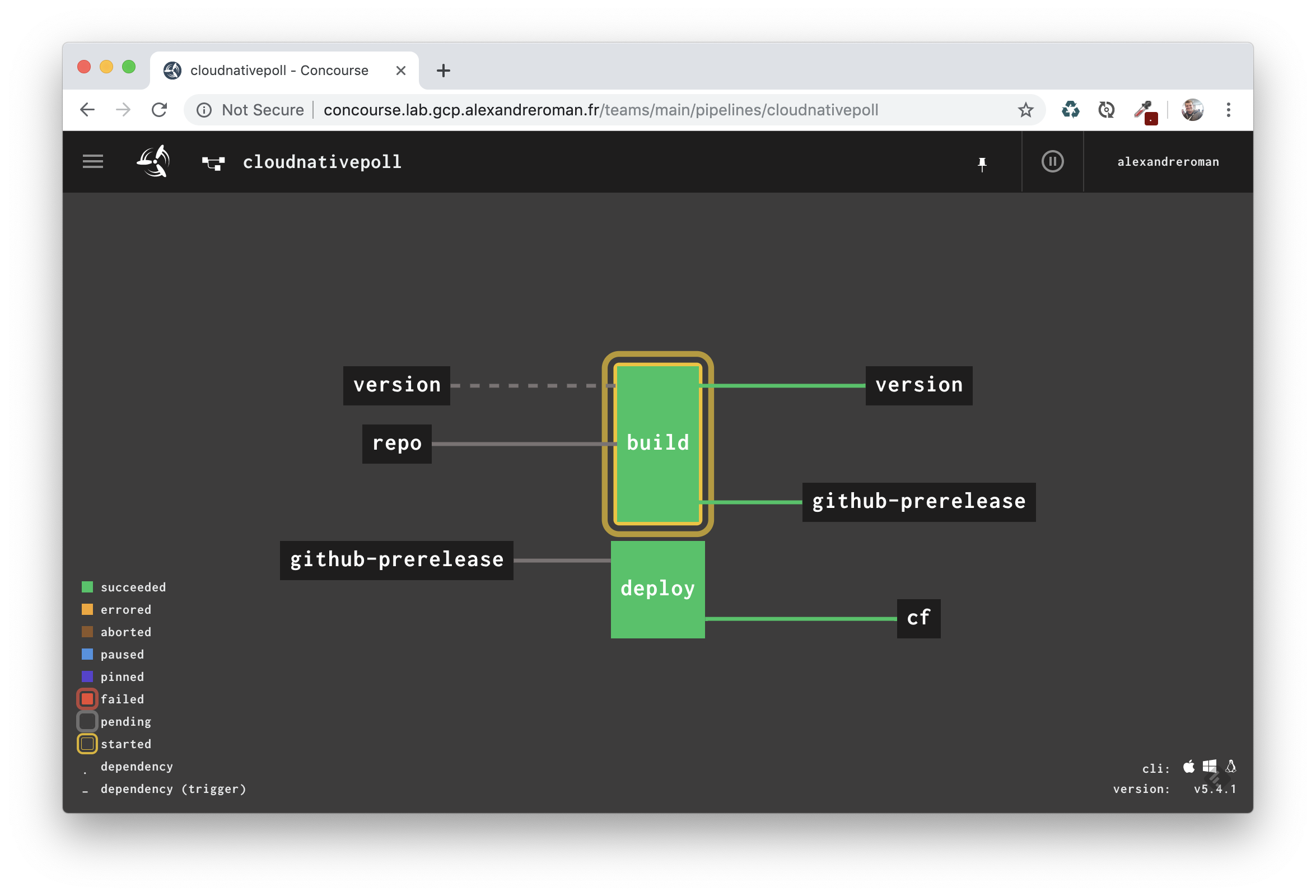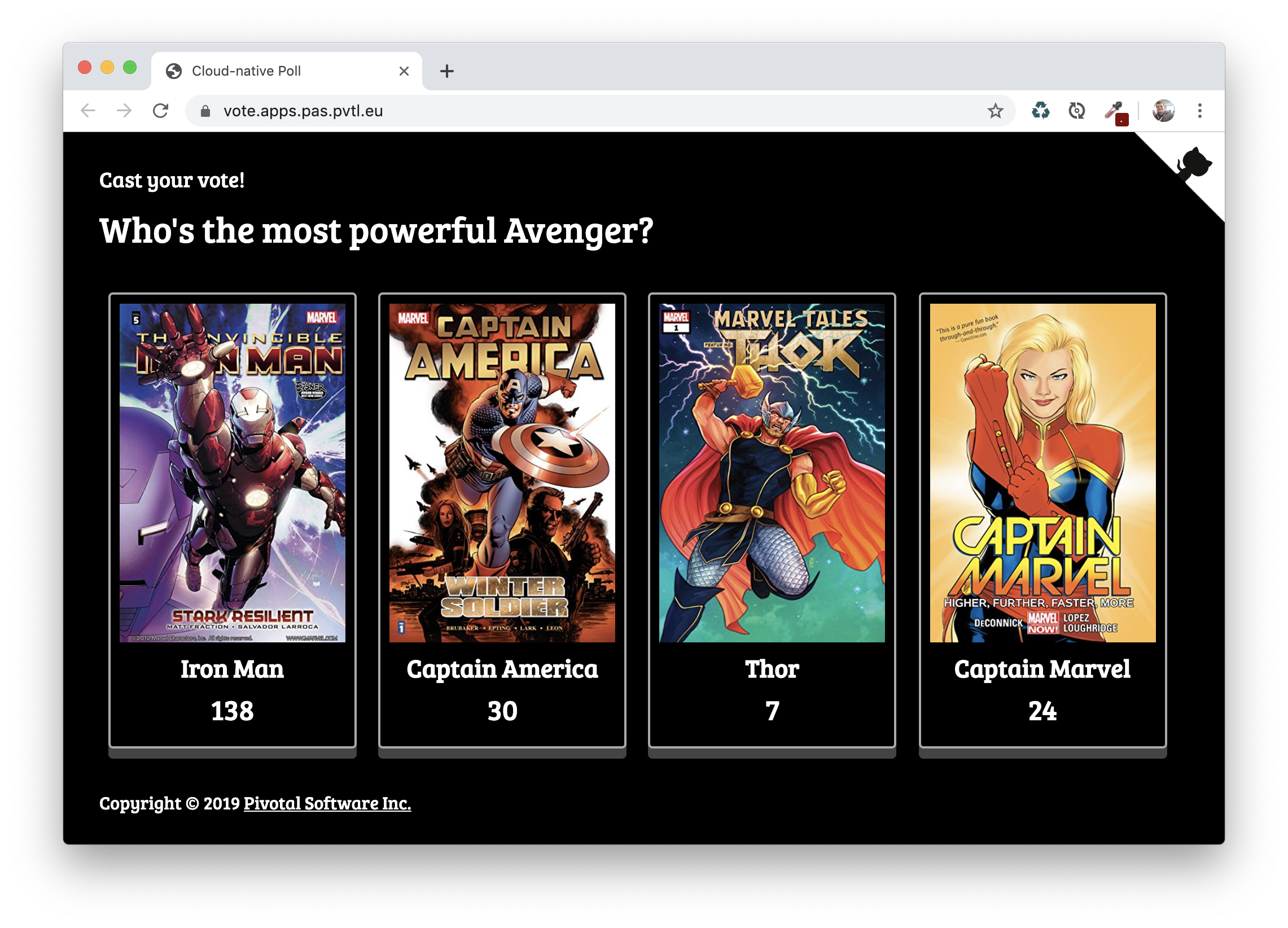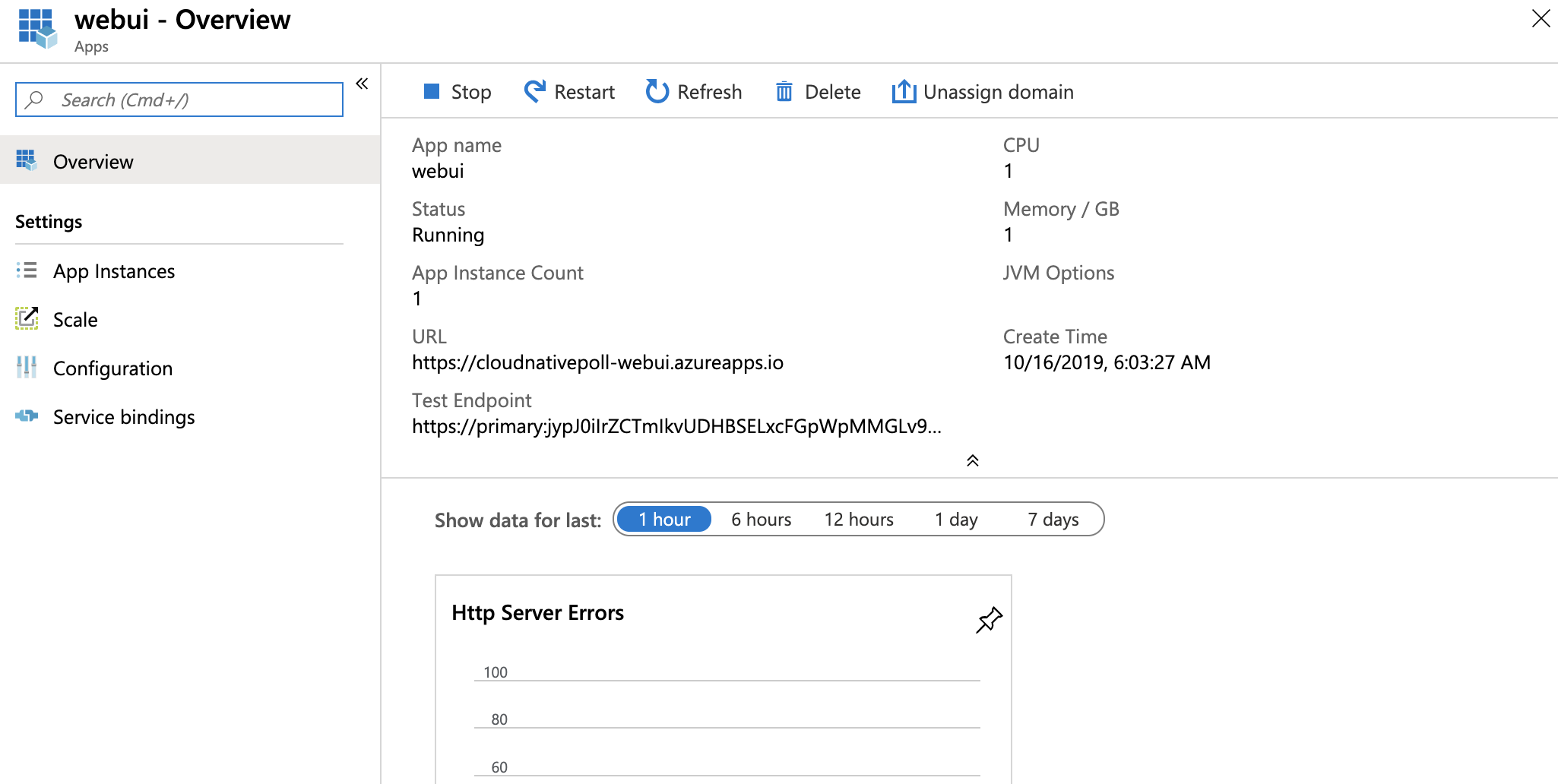Cloud-native Poll app
This project is a cloud-native implementation of a voting app, using modern technologies like Spring Boot, Spring Cloud and Spring Data.
You can freely set up your own questions and thumbnails, using an external Git repository read by Spring Cloud Config Server when the app starts.
Compiling this app
This app is made of 2 microservices: a backend and a Web UI frontend. These microservices leverage a RabbitMQ instance to share messages and a Redis instance to store data. A Netflix Eureka Server is used as a service registry.
You need a JDK 8+ to build this app:
$ ./mvnw clean packageRunning locally
Start a Redis instance using Docker:
$ docker run --rm -p 6379:6379/tcp redis:5Start a RabbitMQ instance:
$ docker run --rm -p 5672:5672/tcp -p 15672:15672/tcp rabbitmq:3-managementThe RabbitMQ management UI is available at http://localhost:15672:
use guest / guest to sign in.
Start a Netflix Eureka Server instance:
$ java -jar eureka-server/target/cloudnativepoll-eureka-server.jarStart the backend:
$ java -jar backend/target/cloudnativepoll-backend.jarStart the frontend:
$ java -jar webui/target/cloudnativepoll-webui.jarThe app is available at http://localhost:8080.
Deploying to Pivotal Platform
Easily deploy this app to Pivotal Platform using these commands:
$ cf create-service p-redis shared-vm redis
$ cf create-service p-rabbitmq standard rabbitmq
$ cf create-service p-service-registry standard service-registry
$ cf create-service -c '{"git": { "uri": "https://github.com/alexandreroman/cloudnativepoll-config", "cloneOnStart": "true" }}' p-config-server standard config-server
$ cf push
$ cf add-network-policy cloudnativepoll-webui --destination-app cloudnativepoll-backendIn case you're using Pivotal Web Services, use these commands:
$ cf create-service p.redis cache-small redis
$ cf create-service cloudamqp lemur rabbitmq
$ cf create-service p-service-registry trial service-registry
$ cf create-service -c '{"git": { "uri": "https://github.com/alexandreroman/cloudnativepoll-config", "cloneOnStart": "true" }}' p-config-server trial config-server
$ cf add-network-policy cloudnativepoll-webui --destination-app cloudnativepoll-backendNote this app is leveraging Container-To-Container (C2C) networking between frontend and backend instances. This way you don't need to expose a public route for backend instances. All instances are discovered using a platform-managed Netflix Eureka Server.
Deploying to Azure Spring Cloud
Azure Spring Cloud is a new platform announced at SpringOne Platform 2019. Use this platform to run your Spring Boot apps on Azure.
Make sure to initialize Azure Spring Cloud with your subscription using this tutorial.
In this document, let's assume you initialize a Spring Cloud cluster named cloudnativepoll.
First, you need to recompile this app to include Azure dependencies and configuration:
$ ./mvnw clean package -PazureWhen this app is running on Azure, the backend leverages Azure Event Hubs and Azure Redis Cache. No source code update is required, thanks to the abstraction level provided by Spring Boot and Spring Cloud.
Initialize some variables based on your Azure Spring Cloud resources:
$ RES_GROUP=$(az spring-cloud list | jq -r ".[].resourceGroup")
$ RES_LOCATION=$(az spring-cloud list | jq -r ".[].location")Create an Event Hubs namespace in your resource group:
$ az eventhubs namespace create --name cloudnativepoll --resource-group $RES_GROUP -l $RES_LOCATIONCreate a storage account (choose a random name):
$ az storage account create -n cloudnativepoll -g $RES_GROUP -l $RES_LOCATION \
--sku Standard_LRS --kind BlobStorage --access-tier HotGet the storage account access key:
$ az storage account keys list -g $RES_GROUP -n cloudnativepoll | jq -r '.[] | select(.keyName=="key1") | .value'
rHw8izcwjzNEzySbh8x0uV6mbWHOFQ88LaEjznbKU26GnEmCnGddImjlmcr7nLH0qzjDeSvWD5y6kB6tqbs9oQ==Create Event Hubs instances (two queues are used by this app):
$ az eventhubs eventhub create --name cloudnativepoll-votes --resource-group $RES_GROUP --namespace-name cloudnativepoll
$ az eventhubs eventhub create --name cloudnativepoll-reset --resource-group $RES_GROUP --namespace-name cloudnativepollCreate Event Hubs consumer groups:
$ az eventhubs eventhub consumer-group create --resource-group $RES_GROUP \
--namespace-name cloudnativepoll --eventhub-name cloudnativepoll-votes --name voter
$ az eventhubs eventhub consumer-group create --resource-group $RES_GROUP \
--namespace-name cloudnativepoll --eventhub-name cloudnativepoll-reset --name instanceGet the Event Hubs connection string:
$ az eventhubs namespace authorization-rule keys list --resource-group $RES_GROUP \
--namespace-name cloudnativepoll --name RootManageSharedAccessKey | jq -r .primaryConnectionString
Endpoint=sb://cloudnativepoll.servicebus.windows.net/;SharedAccessKeyName=RootManageSharedAccessKey;SharedAccessKey=42+/uao51l7orrp3ydcTUDs43JKz2MqRtwI4eCf0RjC=There is no support for binding an Event Hubs instance to Spring Boot apps at this time: you'll need to set up a configuration file to include your Event Hubs credentials.
Create a private GitHub project to store app configuration (this Git repository should be private to keep your Azure credentials secret).
In this repository, create a file application-azure.yml:
# Set poll questions.
poll:
question: Who's the most powerful Avenger?
choices:
- Iron Man
- Captain America
- Thor
- Captain Marvel
images:
- https://images-na.ssl-images-amazon.com/images/S/cmx-images-prod/Item/24008/DEC100687_1._SX360_QL80_TTD_.jpg
- https://images-na.ssl-images-amazon.com/images/S/cmx-images-prod/Item/14688/14688._SX360_QL80_TTD_.jpg
- https://images-na.ssl-images-amazon.com/images/S/cmx-images-prod/Item/744376/744376._SX360_QL80_TTD_.jpg
- https://images-na.ssl-images-amazon.com/images/S/cmx-images-prod/Item/149220/149220._SX360_QL80_TTD_.jpg
spring:
cloud:
azure:
eventhub:
# Include your Event Hubs connection string.
connection-string: "Endpoint=sb://cloudnativepoll.servicebus.windows.net/;SharedAccessKeyName=RootManageSharedAccessKey;SharedAccessKey=42+/uao51l7orrp3ydcTUDs43JKz2MqRtwI4eCf0RjC="
# Include your Azure storage credentials.
checkpoint-storage-account: cloudnativepoll
checkpoint-access-key: "rHw8izcwjzNEzySbh8x0uV6mbWHOFQ88LaEjznbKU26GnEmCnGddImjlmcr7nLH0qzjDeSvWD5y6kB6tqbs9oQ=="Commit and push this file to the Git repository. Now create a Config Server instance on your Azure Spring Cloud cluster, pointing to this Git repository:
This configuration file will be read by the Config Server: your apps running on Azure Spring Cloud will then retrieve these configuration properties.
Create a Redis cache instance (choose a random name):
$ az redis create --name cloudnativepoll-redis --resource-group $RES_GROUP \
--location $RES_LOCATION --vm-size P1 --sku Premium --shard-count 1Create a backend app:
$ az spring-cloud app create -n backendCreate an app for the Web UI (this one is public):
$ az spring-cloud app create -n webui --is-public trueBind the backend app to the Redis instance:
Then, go to app configuration for both backend and webui components and add
an environment variable SPRING_PROFILES_ACTIVE with the value set to azure:
This will enable profile azure: there are some custom configuration properties which
are set when running on Azure Spring Cloud.
Deploy the backend app to Azure:
$ az spring-cloud app deploy -n backend \
--jar-path backend/target/cloudnativepoll-backend.jarDeploy the Web UI to Azure:
$ az spring-cloud app deploy -n webui \
--jar-path webui/target/cloudnativepoll-webui.jarPlease note that you don't need to build a Docker image: Azure Spring Cloud will take care of building a container image for you.
As soon as both apps are deployed to your Azure Spring Cloud cluster, you should see components running with status UP:
Now, go to webui configuration page, and get the app URL:
In this example, hit https://cloudnativepoll-webui.azureapps.io to access the app.
Using Concourse to build and deploy this app
A Concourse pipeline is available is the directory ci:

This pipeline contains a generic job: use this template to create 2 jobs building and deploying the 2 microservices.
Edit file credentials.yml.template and create 2 copies for each microservice:
app: cloudnativepoll-backend-or-webui
git-uri: https://github.com/alexandreroman/cloudnativepoll.git
git-branch: master
git-module: backend-or-webui
# This Git repo stores version files.
git-ci-uri: https://github.com/johndoe/myrepo.git
git-username: johndoe
git-password: accesstoken
# This pipeline deploys apps as GitHub releases.
github-owner: johndoe
github-repo: cloudnativepoll
github-access-token: accesstoken
# Enter your CF credentials here.
cf-api: api.run.pivotal.io
cf-username: johndoe@pivotal.io
cf-password: secret
cf-org: org
cf-space: dev
# Edit this entry to tune the CF manifest used to deploy an app.
cf-manifest: |
---
applications:
- name: ((app))
path: ((app)).jarThen, deploy these jobs using these commands:
$ fly -t concourse set-pipeline -p cnp-backend -c ci/pipeline.yml --load-vars-from ci/credentials-backend.yml
$ fly -t concourse set-pipeline -p cnp-webui -c ci/pipeline.yml --load-vars-from ci/credentials-webui.ymlContribute
Contributions are always welcome!
Feel free to open issues & send PR.
License
Copyright © 2019 Pivotal Software, Inc.
This project is licensed under the Apache Software License version 2.0.





